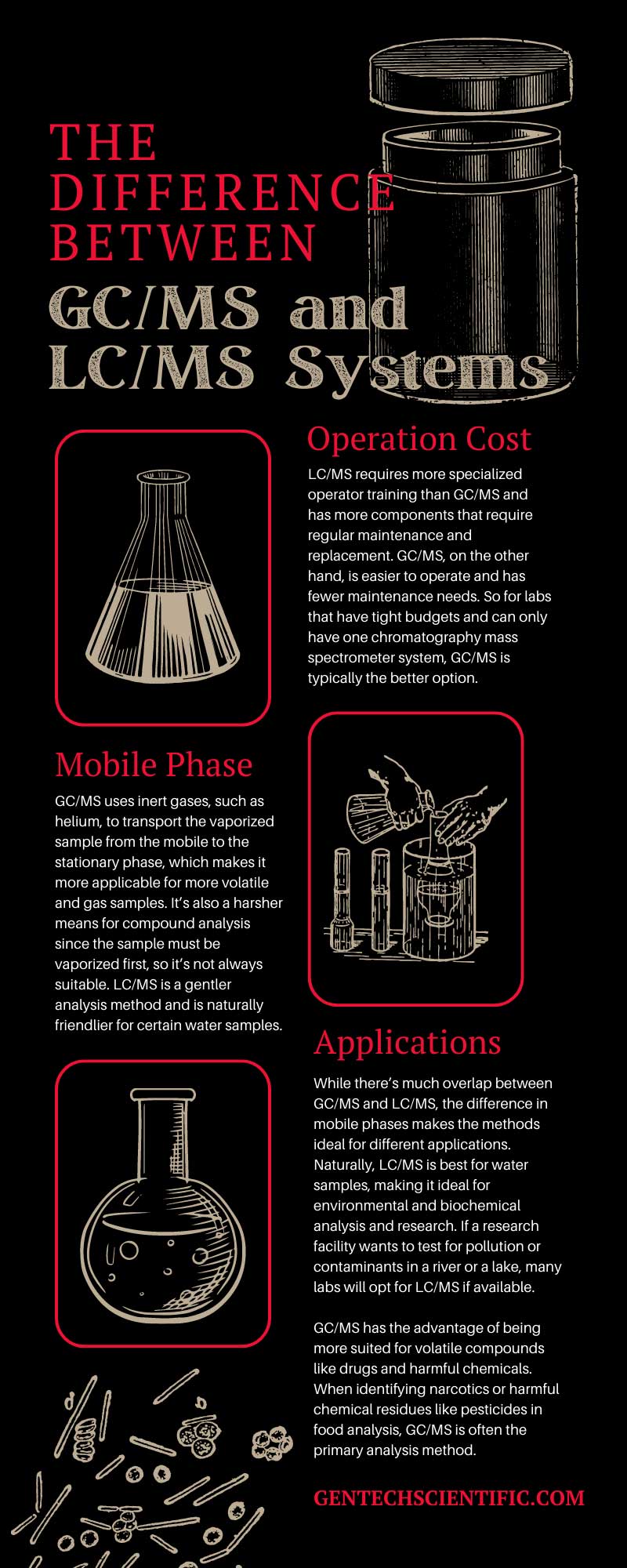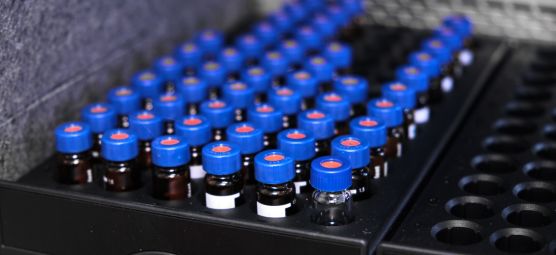Gas chromatography–mass spectrometry (GC/MS) and liquid chromatography–mass spectrometry (LC/MS) are two of the most common chemical identification and analysis methods. But what’s the difference between GC/MS and LC/MS systems? We explore that topic and more below.
What Is GC/MS?
Before we compare and contrast the two chemical identification and quantification methods, we’ll offer brief overviews of GC/MS and LC/MS.
GC/MS is a method for separating chemicals and compounds in a vaporized sample that scientists then quantify and identify in mass spectrometry. The gas chromatography system vaporizes the sample and transports it through the system via a carrier gas—the mobile phase—into the column oven—known as the stationary phase.
The column oven heats the sample to cause separation as the compounds react and then transports the sample to the mass spectrometer once separated. The mass spectrometer detects the speed of the positively charged ions moving through a vacuum chamber toward a negatively charged plate to determine their weight. The mass analyzer of the spectrometer records the speed and abundance of the ions, which then provides a readout. Scientists can compare this readout with the results of other known elements to determine the sample’s composition.
Applications for GC/MS
GC/MS is a useful analytical tool and the gold standard for forensic substance identification due to its accuracy, affordability, quickness, and ability to separate volatile compounds. Some of the most common applications for GC/MS across various industries include the following:
- Drug detection
- Fire investigation
- Environmental analysis
- Food processing safety
What Is LC/MS?
While the LC/MS system is similar, it has some significant differences from its chromatic alternative that sets it apart. LC/MS operates following the same process as GC/MS, where a mobile phase transfers a sample of chemical compounds through a stationary phase for separation. And like with GC/MS, the separated compounds then transfer to mass spectrometers that record the weighted ions.
The significant difference is liquid chromatography uses a liquid medium instead of a gas medium. Also, LC/MS doesn’t use a heated column oven. Instead, LC/MS pushes the sample through the column via a consistent flow rate, as the composition and physical properties of the compound cause some to move slower or faster.
Applications for LC/MS
There’s some overlap in LC/MS and GC/MS applications, but the mobile phase and separation method make LC/MS more suitable for some applications than others. For example, pharmaceutical analysis also uses LC/MS, but it’s more popular in environmental and biotechnology applications like agrochemical and cosmetic testing.
How GC/MS and LC/MS Are Similar
Now that we understand the basics of these two analytical testing methods, we can look closer at how they compare and contrast, starting with how they’re similar.
Sample Separation and Identification
Most importantly, both GC/MS and LC/MS accomplish the same goal of identifying unknown chemicals in a sample by separating the compounds, weighing them, and comparing them with known ones. There are many modern-day applications for which identifying and quantifying unknown chemical compounds is necessary. One such example is searching for trace residues of ignition sources at a crime scene or quantifying trace residues in food processing.
Some samples are more suited for GC/MS or LC/MS, as GC/MS is better at identifying more volatile compounds. However, not every sample can be vaporized for GC/MS. Fortunately, GC/MS and LC/MS cover most of the testing needs for the industries that must identify chemical compounds.
Mobile and Stationary Phases
Another similarity in GC/MS and LC/MS testing is the basic combination of separation methods—i.e., using a mobile and stationary phase. Both methods provide a mobile phase that separates the sample into a column, which is the stationary phase.
GC/MS and LC/MS use different methods to accomplish this separation in the stationary phase, but the basic principles are the same. And once the chemical compounds are separated, both systems use mass spectrometer identification and quantification.
How GC/MS and LC/MS Are Different
While GC/MS and LC/MS are quite similar, significant contrasts between the systems make each more suitable for certain industries and testing labs.
Operation Cost
One of the key differences between LC/MS and GC/MS that every lab must consider is the cost of operation. GC/MS is often preferable because it’s a more affordable operation for most labs for many reasons.
For one, LC/MS requires more specialized operator training than GC/MS and has more components that require regular maintenance and replacement. GC/MS, on the other hand, is easier to operate and has fewer maintenance needs. So for labs that have tight budgets and can only have one chromatography mass spectrometer system, GC/MS is typically the better option.
Mobile Phase
The glaring difference between GC/MS and LC/MS rests in their mobile phases. As we’ve discussed, GC/MS uses a gas mobile phase, while LC/MS uses a mixture of liquids and buffers or additives for its carrier phase.
GC/MS uses inert gases, such as helium, to transport the vaporized sample from the mobile to the stationary phase, which makes it more applicable for more volatile and gas samples. It’s also a harsher means for compound analysis since the sample must be vaporized first, so it’s not always suitable. LC/MS is a gentler analysis method and is naturally friendlier for certain water samples.
Applications
While there’s much overlap between GC/MS and LC/MS, the difference in mobile phases makes the methods ideal for different applications. Naturally, LC/MS is best for water samples, making it ideal for environmental and biochemical analysis and research. If a research facility wants to test for pollution or contaminants in a river or a lake, many labs will opt for LC/MS if available.
GC/MS has the advantage of being more suited for volatile compounds like drugs and harmful chemicals. When identifying narcotics or harmful chemical residues like pesticides in food analysis, GC/MS is often the primary analysis method.
Conclusion
We hope our brief comparison of GC/MS and LC/MS has been helpful and informative. If you’re interested in purchasing LC/MS or GC/MS equipment or would like to sell lab equipment for fast cash, GenTech Scientific can help. Browse our inventory of lab equipment or fill out a form with information regarding the lab instruments you want to sell. Our staff will be in touch shortly to help with the process!







